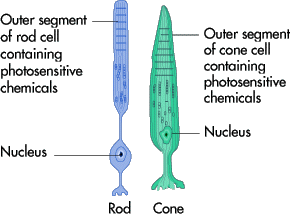In November 2006, the journal "Nature" published a paper describing how a cell transplant had allowed blind mice to see again. News reports suggested that the research could lead to cures for conditions like macular degeneration, the leading cause of blindness in elderly people in developed countries. To some, the findings seemed almost miraculous, especially since such conditions usually cause irreversible loss of vision.
The mice in the study had been bred to have eyes that did not work properly for the purpose of scientific research. They had rods and cones -- also called photoreceptor cells -- that did not function. Rods and cones, located on your retina, allow your eyes to detect light. When light hits your rods and cones, a complex chemical reaction takes place. This reaction causes electrical impulses to travel along your optic nerve to your brain. Your brain interprets the impulses as a picture. You can learn more about this process in How Vision Works.
Advertisement
People can lose their sight when their rods and cones die or stop working properly, since the body does not replace these cells. In some cases, doctors can slow down the loss of photoreceptors, but often the condition is untreatable. Researchers have theorized that stem cells, special cells that can grow into any type of cell, may be able create new rods and cones. This could cure specific types of blindness.
Researchers have used stem cells to grow several types of eye tissue, but many have focused on the retina. Several common, untreatable forms of blindness are the direct result of problems with the retina and photoreceptor cells. In addition, these types of blindness usually leave the optic nerve and other eye structures undamaged.
The researchers who performed the study discussed in "Nature" used retinal precursor cells for transplants. These are cells that have already started to transform into retinal cells. Researchers harvested these cells from other mice, which were between two and five days old, and transplanted them into the blind mice's eyes. After receiving the transplant, the blind mice's pupils began to dilate in response to light, and their optic nerves became active. For these reasons, researchers believe the mice became able to see. Exactly what the mice are able to see is less clear.
This research suggests that similar procedures could restore the sight of people whose rods and cones are dying or are not working properly. However, this method has a notable downfall. To replicate this precise procedure in humans, doctors would have to harvest retinal precursor cells from second-trimester fetuses. In most medical communities, this would not be an acceptable or ethical practice.
Researchers may be able to refine the technique using adult stem cells. These are cells that exhibit stem-cell-like properties but exist in adult bodies rather than in embryos. People have adult stem cells in several of their organs, including their retinas. Doctors may discover how to perform the procedure using a person's own stem cells. If a person's loss of vision comes from genetic factors, though, these stem cells would carry the same defects as the cells they were replacing. Such a transplant might delay, but not prevent or treat, blindness.
Here are some links to more information about stem cells, blindness and recent research:
Advertisement
